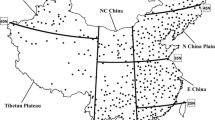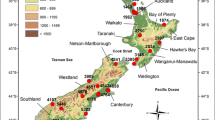Abstract
The observed long-term trends in extreme temperatures in Hong Kong were studied based on the meteorological data recorded at the Hong Kong Observatory Headquarters from 1885–2008. Results show that, over the past 124 years, the extreme daily minimum and maximum temperatures, as well as the length of the warm spell in Hong Kong, exhibit statistically significant long-term rising trends, while the length of the cold spell shows a statistically significant decreasing trend. The time-dependent return period analysis also indicated that the return period for daily minimum temperature at 4°C or lower lengthened considerably from 6 years in 1900 to over 150 years in 2000, while the return periods for daily maximum temperature reaching 35°C or above shortened drastically from 32 years in 1900 to 4.5 years in 2000. Past trends in extreme temperatures from selected weather stations in southern China from 1951–2004 were also assessed. Over 70% of the stations studied yielded a statistically significant rising trend in extreme daily minimum temperature, while the trend for extreme maximum temperatures was found to vary, with no significant trend established for the majority of stations.
Similar content being viewed by others
References
Bornstein, R. D., 1968: Observations of the urban heat island effect in New York City. J. Applied Meteor., 7, 575–582.
Coles, S. G., 2001: An Introduction to Statistical Modeling of Extreme Values. Springer-Verlag, London, 208pp.
Ding, X., Li, D. W. Zheng, and S. Yang, 2002: Variations of the surface temperature in Hong Kong during the last century. Int. J. Climatol., 22, 715–730.
Easterling, D. R., and Coauthors, 1997: Maximum and minimum temperature trends for the globe. Science, 277, 364–367.
Fong, S. K., C. H. Wu, A. Wang, Z. J. He, T. Wang, K. C. Leong, and U. M. Lai, 2009: Analysis of surface air temperature change in Macau during 1901–2007. Advance in Climate Change Research, 5(1), 12–17.
Frich, P., L.V. Alexander, P. Della-Marta, B. Gleason, M. Haylock, A. M. G. Klein Tank, and T. Peterson, 2002: Observed coherent changes in climate extremes during the second half of the twentieth century. Climate Res., 19, 193–212.
Ginn, W. L., T. C. Lee, and K. Y. Chan, 2010: Past and future changes in the climate of Hong Kong. Acta Meteor. Sinica, 24(2), 163–175.
Grimmond, S., 2007: Urbanization and global environmental change: Local effects of urban warming. The Geographical Journal, 173(1), 83–88.
Guangdong Meteorological Bureau, 2007: Assessment report on Climate change of Guangdong (Selection). Guangdong Meteorology, 29(3), 1–6. (in Chinese)
Hong Kong Observatory, 2008: Summary of Meteorological Observations in Hong Kong 2007, 101pp.
Hong Kong Observatory, 2009: Summary of Meteorologi cal and Tidal Observations 2008, 101pp.
H. von Storch, and F. W. Zwiers, 1999: Statistical Analysis in Climate Research. Cambridge University Press, Cambridge, UK, 484pp.
IPCC, 2007a: Climate Change 2007: The Physical Science Basis. Contribution of the Working Group I to the Fourth Assessment Report of the Intergovernmental Panel on Climate Change, Solomon et al., Eds., Cambridge University Press, Cambridge, United Kingdom and New York, NY, USA, 996pp.
IPCC, 2007b: Summary for Policymakers. Climate Change 2007: Impacts, Adaptation and Vulnerability. Contribution of Working Group II to the Fourth Assessment Report of the Intergovernmental Panel on Climate Change, Parry et al., Eds., Cambridge University Press, Cambridge, UK, 7–22.
Kalande, B. D., and T. R. Oke, 1980: Suburban energy balance estimates for Vancouver, B.C., using the Bowen ratio energy balance approach. Journal of Applied Meteorology, 19, 791–802.
Karl, T. R., and Coauthors, 1993: A new perspective on recent global warming: Asymmetric trends of daily maximum and minimum temperature. Bull. Amer. Meteor. Soc., 74, 1007–1023.
Kharin, V. V., and F. W. Zwiers, 2005: Estimating extremes in transient climate change simulations. J. Climate, 18, 1156–1173.
Lee, T. C., W. M. Leung, and K. W. Chan, 2006: Climatological normals for Hong Kong 1971–2000. Hong Kong Observatory Technical Note (Local), No. 83, 37pp.
Leung, Y. K., K. H. Yeung, E. W. L. Ginn, and W. M. Leung, 2004: Climate Change in Hong Kong. Hong Kong Observatory Technical Note, No. 107, 48pp.
Leung, Y. K., K. M. Yip, and K. H. Yeung, 2007: Relationship between thermal index and mortality in Hong Kong. Meteorological Applications, 15(3), 399–409.
Li, Q. X., H. Z. Zhang, J. Chen, W. Li, Z. N. Liu, and P. Jones, 2009: A mainland China homogenized historical temperature dataset of 1951–2004. Bull. Amer. Meteorol. Soc., 90, 1062–1065.
Oke, T. R., 1982: The energetic basis of the urban heat island. Quart. J. Roy. Meteorol. Soc., 108, 1–24.
Peterson, P., 1981: Extreme temperatures in Hong Kong. Hong Kong Observatory Technical Note (Local), No. 22, 41pp.
Peterson, T. C., 2005: Climate Change Indices. WMO Bulletin, 54(2), 83–86.
Peterson, T. C., and Coauthors, 2001: Report on the activities of the working group on climate change detection and related rapporteurs 1998–2001. WMO, Rep. WCDMP-47, WMO-TD 1071, Geneve, Switzerland, 143pp.
Wu, M. C., Y. K. Leung, W. M. Lui, and T. C. Lee, 2008: A study on the difference between urban and rural climate in Hong Kong. 22nd Guangdong-Hong Kong-Macau Seminar on Meteorological Science and Technology, Zhongshan, China, Hong Kong Observatory Reprint 745, 23pp.
Zhai, P. M., and X. H. Pan, 2003: Trends in temperature extremes during 1951–1999 in China. Geophys. Res. Lett., 30(17), 1913.
Zhang, D. F., A. S. Zakey, X. J. Gao, F. Giorgi, and F. Solmon, 2009: Simulation of dust aerosol and its regional feedbacks over East Asia using a regional climate model. Atmos. Chem. Phys., 9, 1095–1110.
Zhou, K. M., R. E. Dickinson, Y. H. Tian, J. Y. Fang, Q. Z. Li, R. K. Kaufmann, C. J. Tucker, and R. B. Myneni, 2004: Evidence for a significant urbanization effect on climate in China. Proceedings of the National Academy of Sciences, Vol. 101, No. 26, 9540–9544.
Author information
Authors and Affiliations
Corresponding author
Rights and permissions
About this article
Cite this article
Lee, T.C., Chan, H.S., Ginn, E.W.L. et al. Long-term trends in extreme temperatures in Hong Kong and southern China. Adv. Atmos. Sci. 28, 147–157 (2011). https://doi.org/10.1007/s00376-010-9160-x
Received:
Revised:
Published:
Issue Date:
DOI: https://doi.org/10.1007/s00376-010-9160-x




